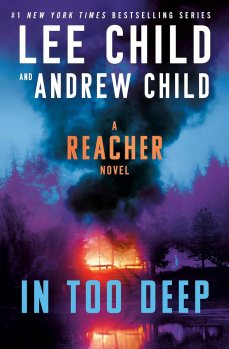DEAN POLING: Book Reviews for Nov. 8
Published 8:21 am Thursday, November 7, 2024
In Too Deep: Lee Child & Andrew Child
In February 2022, I cracked open my first Jack Reacher novel by Lee Child.
Nearly three years and almost 30 novels later, I’ve set down the latest Jack Reacher novel by Lee Child written in partnership with his brother, Andrew Child.
Roughly every month, between books on history, novels, biographies and other thrillers, I read a Jack Reacher book. My father-in-law urged me to read these books about a decade ago but I didn’t start reading them until watching the first season of “Reacher” on Amazon Prime.
It’s been a fun ride.
Reacher hasn’t changed much from “Killing Floor,” the first book released in the 1990s, to “In Too Deep,” the latest book published in October 2024.
He’s still a former Army military police officer, criss-crossing America by hitch-hiking and by bus. Recurring characters are rare, really non-existent. He moves from place to place, person to person, book to book. He remains physically massive, savvy, indomitable.
He has no car, no house, no property, except for the clothes on his back, his expired passport, some cash and the portable toothbrush he keeps folded in his pants pocket.
Plenty of things have changed around him: the advent of personal computers, internet, smart phones, increased security measures, etc.
Plenty changed in the past few years, when Lee Child was joined by Andrew Child in penning the Reacher novels. The stories are more fast-paced with fewer insights into the interior lives of the characters.
The same holds true for “In Too Deep.” Here, Reacher awakes injured, cuffed and being held captive. He can’t recall anything leading to the accident that injured him and impaired his memory. The memories are slow to return but Reacher is quick in escaping his captors and he is soon in the middle of a situation that could change the world.
The Child-partnered books rarely refer to Reacher’s age. For good reason. The early books note his youth growing up around the world, the son of a career Marine. Reacher would be in his 60s, according to information from those earliest novels. Age and relentless decades on the road would begin to erode the momentum of even the strongest person.
It’s been a great series. I will miss returning to his adventures every few weeks. There are other Reacher-related series – such as a series following a supporting character from past Reacher novels and a series based on Reacher’s adventures as a kid – but I can’t imagine glomming onto them like I did Lee Child’s Reacher books.
Like other fans, I now must wait a year until the next Reacher novel is published.
This Isn’t Going to End Well: Daniel Wallace
In his most famous book, the novel “Big Fish,” Daniel Wallace explores a son’s dysfunctional relationship with his tall-tale-telling father. The son discovers that his father’s life was as rich in adventures and people as the stories he told.
In the non-fiction “This Isn’t Going to End Well: The True Story of a Man I Thought I Knew,” Wallace learns that his larger-than-life brother-in-law lived a separate interior life that no one would have ever guessed.
William Nealy was an adventurous cartoonist who, among other things, white-watered and charted rapids, was a builder, an outdoorsman, a caretaker, an EMT, an author of 10 published books, an explorer, etc. Nealy was the high school boyfriend of Wallace’s sister. Wallace was a kid when he first encountered Nealy repeatedly diving from the roof of the family house into the pool.
From that moment, Nealy became the younger Wallace’s hero while Nealy became his sister’s life companion.
To all appearances, Nealy was the larger-than-life character he seemed; he lived a life and had a career that many people would envy. So, it was a shock when Nealy died by his own hand at the age of 48.
Wallace’s book tries to unpack Nealy’s life and its impact on him and others more than 20 years after that death. Wallace discovered that the man he believed a hero lived a tortured inner life that Nealy tragically kept to himself. An inner life that eventually consumed him.
Though a sad book, Wallace’s talent for telling a story draws readers into this personal and painful journey. Wallace likely felt compelled to tell this story as a catharsis for himself but it will touch the lives of so many more.





